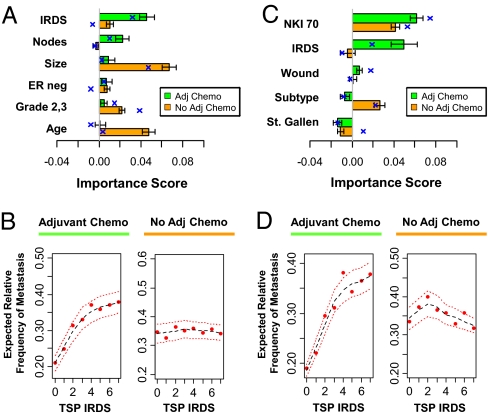Fig. 4.
The IRDS is a therapy-predictive marker for ADCT. The 110 patients treated with ADCT (green) and the 185 patients not treated with ADCT (orange) from the NKI295 data set were separately analyzed using either a RSF analysis (see text) or Cox regression. The TSP IRDS was combined with (A and B) standard clinicopathological factors or (C and D) clinical risk groups [St. Gallen criteria (4)] and other gene expression signatures (NKI 70, wound, and molecular subtype). (A and C) The contribution of each covariate to overall prediction accuracy of each full model is measured by its importance score (see text). Importance scores from RSF analysis are shown by the horizontal bar plot (mean ± SD) and mean importance scores from Cox regression are superimposed (blue cross). (B and D) The partial plots show expected relative frequency of metastasis as a function of the TSP IRDS score after adjusting for all other covariates and interactions. The estimated risk is shown (red dot) with a Lowess regression (black dashes) ± 2SE (red dashes). See Fig. S3 for partial plots of other covariates. The prediction errors for the RSF models for A and C in the absence of ADCT are 30.7% and 35.9%, respectively, and in the presence of ADCT are 35.7% and 37.3%, respectively. The prediction errors for the Cox models for A and C in the absence of ADCT are 32.5% and 31.5%, respectively, and in the presence of ADCT are 34.5% and 32.5%, respectively.

